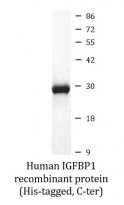ARG70283
Human IGFBP1 recombinant protein (His-tagged, C-ter)
Human IGFBP1 recombinant protein (His-tagged, C-ter) for Binding Activity,SDS-PAGE and Human
Overview
| Product Description | HEK293 expressed, His-tagged (C-ter) Human IGFBP1 recombinant protein. |
|---|---|
| Tested Reactivity | Hu |
| Tested Application | Binding, SDS-PAGE |
| Target Name | IGFBP1 |
| Species | Human |
| A.A. Sequence | Ala26 - Asn259 of Human IGFBP1 (NP_000587.1) with 6X His tag at the C - terminus. |
| Expression System | HEK293 |
| Alternate Names | IBP-1; IBP1; PP12; IGF-BP25; Insulin-like growth factor-binding protein 1; hIGFBP-1; IGFBP-1; Placental protein 12; AFBP; IGF-binding protein 1 |
Application Instructions
| Application Note | Binding activity test: Measured by its binding ability in a functional ELISA. Immobilized Recombinant Human IGFBP-1 at 5µg/ml (100 µl/well) can bind Recombinant Human IGF1 with a linear range of 44-176 ng/ml. |
|---|
Properties
| Form | Powder |
|---|---|
| Purification Note | 0.22 µm filter sterilized. Endotoxin level is <0.1 EU/µg of the protein, as determined by the LAL test. |
| Purity | > 97% (by SDS-PAGE) |
| Buffer | PBS (pH 7.4) |
| Reconstitution | Reconstitute to a concentration of 0.1 - 0.5 mg/ml in sterile distilled water. |
| Storage Instruction | For long term, lyophilized protein should be stored at -20°C or -80°C. After reconstitution, aliquot and store at -20°C for up to one month, at 2-8°C for up to one week. Storage in frost free freezers is not recommended. Avoid repeated freeze/thaw cycles. Suggest spin the vial prior to opening. |
| Note | For laboratory research only, not for drug, diagnostic or other use. |
Bioinformation
| Gene Symbol | IGFBP1 |
|---|---|
| Gene Full Name | insulin-like growth factor binding protein 1 |
| Background | This gene is a member of the insulin-like growth factor binding protein (IGFBP) family and encodes a protein with an IGFBP N-terminal domain and a thyroglobulin type-I domain. The encoded protein, mainly expressed in the liver, circulates in the plasma and binds both insulin-like growth factors (IGFs) I and II, prolonging their half-lives and altering their interaction with cell surface receptors. This protein is important in cell migration and metabolism. Low levels of this protein may be associated with impaired glucose tolerance, vascular disease and hypertension in human patients. [provided by RefSeq, Aug 2017] |
| Function | IGF-binding proteins prolong the half-life of the IGFs and have been shown to either inhibit or stimulate the growth promoting effects of the IGFs on cell culture. They alter the interaction of IGFs with their cell surface receptors. Promotes cell migration. [UniProt] |
| Cellular Localization | Secreted. [UniProt] |
| Calculated MW | 28 kDa |
| PTM | Phosphorylated; probably by casein kinase II. Phosphorylation alters the affinity of the protein for IGFs. In amniotic fluid, the unmodified protein is the most abundant form, while mono-, bi-, tri- and tetraphosphorylated forms are present in decreasing amounts. The phosphorylation state may influence the propensity to proteolysis. [UniProt] |
Images (1) Click the Picture to Zoom In






